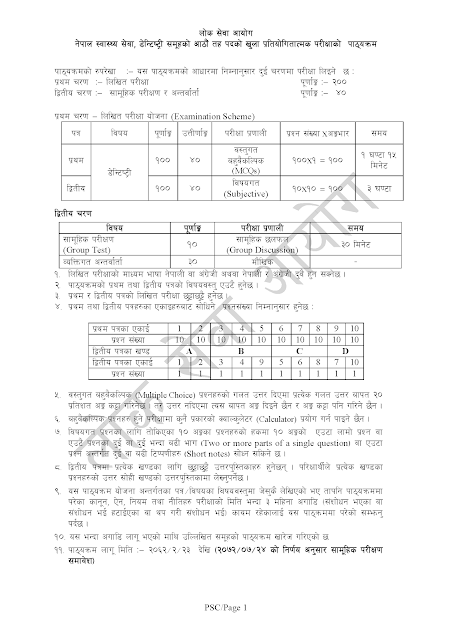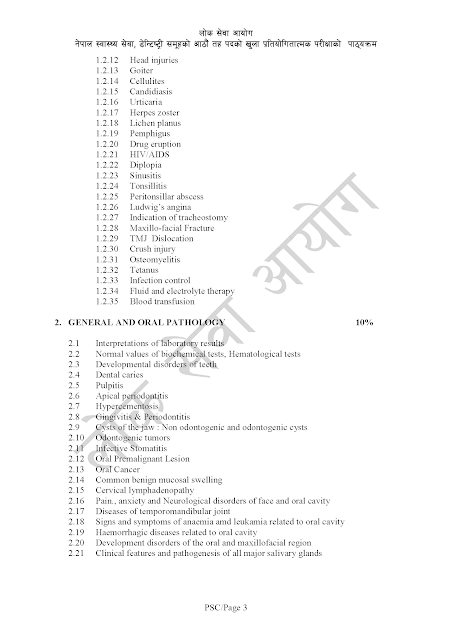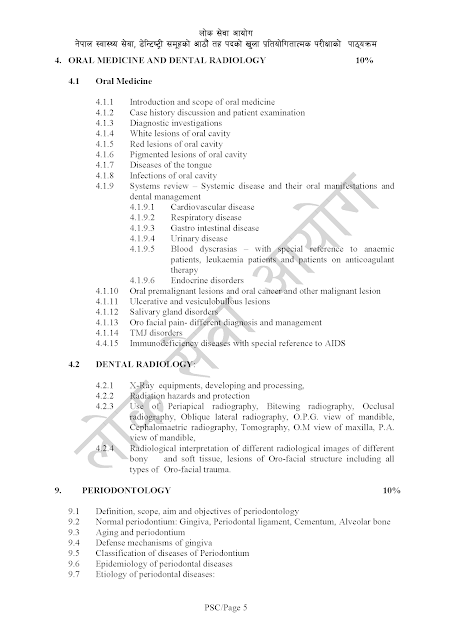SEARCH:
Lok Sewa Aayog - Dentistry - 8th Level - BDS - Exam Curriculum Download
This is the Curriculum Prescribed by Lok Sewa Aayog Nepal, for the Exam of Nepal Health Service, 8th Level Dentistry.
#Mnemonics - Steps in Planning and Evaluation - Public Health Dentistry
The steps involved in the Planning Process are:
1. Identifying the Problem
2. Determining Priorities
3. Development of Program goals, objectives, and activities
4. Resources Identification
5. Constraints Identification
6. Alternative Strategies
7. Developing Implementation Strategies
8. Implementation
9. Monitoring
10. Evaluation
These steps can be memorized with the help of an expression mnemonics - @ Identifying Determined Girl/Guy Requires Conscious Strategies Implementing IME ( Ingenuity, Morality and Emotions)
Identifying - 1. Identifying the Problem
Determined - 2. Determining Priorities
Girl /Guy - 3. Development of Program goals, objectives, and activities
Requires - 4. Resources Identification
Conscious - 5. Constraints Identification
Strategies - 6. Alternative Strategies
Implementing - 7. Developing Implementation Strategies
I - 8. Implementation
M - 9. Monitoring
E -10. Evaluation
1. Identifying the Problem
2. Determining Priorities
3. Development of Program goals, objectives, and activities
4. Resources Identification
5. Constraints Identification
6. Alternative Strategies
7. Developing Implementation Strategies
8. Implementation
9. Monitoring
10. Evaluation
These steps can be memorized with the help of an expression mnemonics - @ Identifying Determined Girl/Guy Requires Conscious Strategies Implementing IME ( Ingenuity, Morality and Emotions)
Identifying - 1. Identifying the Problem
Determined - 2. Determining Priorities
Girl /Guy - 3. Development of Program goals, objectives, and activities
Requires - 4. Resources Identification
Conscious - 5. Constraints Identification
Strategies - 6. Alternative Strategies
Implementing - 7. Developing Implementation Strategies
I - 8. Implementation
M - 9. Monitoring
E -10. Evaluation
#MCQ 12 - Which of the following tooth has the highest endodontic failure rate?
#MCQ 12 - Which of the following tooth has the highest endodontic failure rate?
A. Maxillary First Molar
B. Maxillary First Premolar
C. Mandibular First Molar
D. Mandibular Second Premolar
Answer: A. Maxillary First Molar
The pulp chamber of the maxillary first molar is the largest in the dental arch.
The maxillary first molars are three rooted, two buccal and one palatal. The tooth usually has four root canals, the additional canal being located in the mesiobuccal root. The pulp chamber floor has a quadrilateral shape, although it is sometimes described as triangular. All the canal orifices lie mesial to the oblique ridge which makes it possible to preserve it (oblique ridge) during access preparation.
CLICK HERE TO VIEW ALL MCQS
A. Maxillary First Molar
B. Maxillary First Premolar
C. Mandibular First Molar
D. Mandibular Second Premolar
Answer: A. Maxillary First Molar
The pulp chamber of the maxillary first molar is the largest in the dental arch.
The maxillary first molars are three rooted, two buccal and one palatal. The tooth usually has four root canals, the additional canal being located in the mesiobuccal root. The pulp chamber floor has a quadrilateral shape, although it is sometimes described as triangular. All the canal orifices lie mesial to the oblique ridge which makes it possible to preserve it (oblique ridge) during access preparation.
CLICK HERE TO VIEW ALL MCQS
#MCQ 11 - Regarding Electric Pulp Test for tooth vitality assessment, all of the following statements are true EXCEPT:
#MCQ 11 - Regarding Electric Pulp Test (EPT) for tooth vitality assessment, all of the following statements are true EXCEPT:
A. The objective is to stimulate a pulpal response by subjecting the tooth to an increasing degree of electric current
B. Any restorations in the tooth or the adjacent gingival tissue should not be contacted with the electrolyte or the electrode
C. The test is always performed on the tooth in question prior to testing on a control tooth
D. Gloves should not be worn while performing EPT because it may cause false negative responses
Answer:
C. The test is always performed on the tooth in question prior to testing on a control tooth
This statement is a false statement because, the test is always performed on a control tooth first, and then only on the tooth in question.
EPT checks the sensibility of a tooth by stimulating nerve endings with a low current and high potential difference in voltage. Although manufacturers of this device give normal reference values of current, the best way to check "normal/baseline" values is to use it on adjacent (nonpathological) teeth. This is then compared with the values obtained on the tooth being questioned. The EPT uses electrical excitation to stimulate the A-delta sensory fibers in the pulp.
Any restorations in the tooth or the adjacent gingival tissue should not be contacted with the electrolyte or the electrode because this may give a misleading response.
The electric Pulp test cannot be solely depended on for testing pulp vitality, results should be confirmed by other vitality tests like cold test or test cavity.
The most ideal way of performing a pulp sensibility test is a combination of cold test and Electric Pulp Test (EPT).
CLICK HERE TO VIEW ALL MCQS
A. The objective is to stimulate a pulpal response by subjecting the tooth to an increasing degree of electric current
B. Any restorations in the tooth or the adjacent gingival tissue should not be contacted with the electrolyte or the electrode
C. The test is always performed on the tooth in question prior to testing on a control tooth
D. Gloves should not be worn while performing EPT because it may cause false negative responses
Answer:
C. The test is always performed on the tooth in question prior to testing on a control tooth
This statement is a false statement because, the test is always performed on a control tooth first, and then only on the tooth in question.
EPT checks the sensibility of a tooth by stimulating nerve endings with a low current and high potential difference in voltage. Although manufacturers of this device give normal reference values of current, the best way to check "normal/baseline" values is to use it on adjacent (nonpathological) teeth. This is then compared with the values obtained on the tooth being questioned. The EPT uses electrical excitation to stimulate the A-delta sensory fibers in the pulp.
Any restorations in the tooth or the adjacent gingival tissue should not be contacted with the electrolyte or the electrode because this may give a misleading response.
The electric Pulp test cannot be solely depended on for testing pulp vitality, results should be confirmed by other vitality tests like cold test or test cavity.
The most ideal way of performing a pulp sensibility test is a combination of cold test and Electric Pulp Test (EPT).
CLICK HERE TO VIEW ALL MCQS
Subscribe to:
Posts (Atom)












